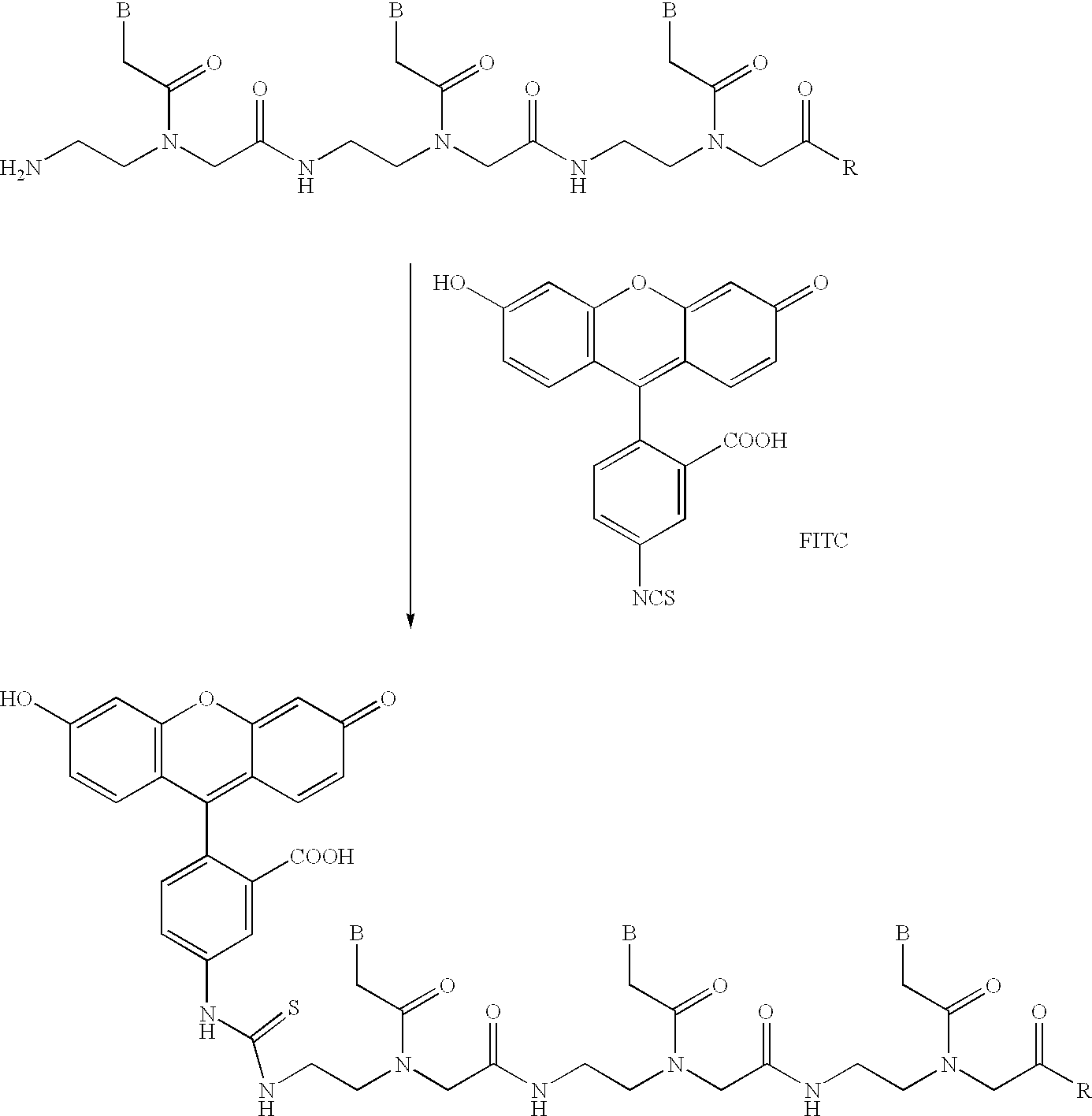Polyamide nucleic acid derivatives, and agents and processes for preparing them
- Summary
- Abstract
- Description
- Claims
- Application Information
AI Technical Summary
Benefits of technology
Problems solved by technology
Method used
Image
Examples
example 1
Synthesizing the PNA Chain
[0136]The following reagents were used for preparing the PNA moiety:[0137]1. Phosphoramidite reagent (0.1 M in acetonitrile (ACN))[0138]2. Mmt-PNA monomers and / or Dmt-oeg-PNA monomers (0.2 M in DMF:ACN (1:1; v:v))[0139]3. Anhydrous ACN (≦30 ppm of water)[0140]4. Trichloroacetic acid (3%) in dichloromethane (DCM)[0141]5. Acetic anhydride, 2,6-lutidine in THF (1:1:8; v:v:v); (Cap A)[0142]6. N-Methylimidazole (16%) in THF; (Cap B)[0143]7. Iodine solution (0.05 M) in THF, water, pyridine (7:2:1; v:v:v)[0144]8. Washing solution (THF, water, pyridine (7:2:1; v:v:v))[0145]9. Tetrazole (0.3 M) in ACN[0146]10. HBTU; 0.2 M in DMF:ACN (1:1; v:v)[0147]11. DIPEA; 0.2 M in DMF:ACN (1:1; v:v)[0148]12. DMF (>99.5%)[0149]13. Solid phase support: aminopropyl-CPG (550 A) loaded with Mmt-aminohex-1-yl hemisuccinate (for PNA-hexylamides).
[0150]The Mmt / acyl-protected or Dmt / acyl-protected oeg monomers were prepared as has already been described (Breipohl et al. (1997) Tetrahedro...
example 2
Synthesizing acetyl-tat tcc gtc at-aminohexyl-p (PNA-1)
[0161]The Dmt protecting group was first of all eliminated from the bishydroxyethylsulfonyl support 1 (1 μmol, FIG. 6) by treating with 3% trichloroacetic acid. The free hydroxyl function was then reacted with the amino modifier C6 phosphoramidite 13 (FIG. 4d) using tetrazole as catalyst. The reaction employs an excess of the phosphorylating reagent 13 (approx. 25-fold), as an 0.3 M solution in acetonitrile / tetrahydrofuran (1:1; v:v), and the tetrazole (approx. 50-fold; 0.5 M in acetonitrile). After the condensation took place, oxidation was effected using an iodine solution (0.05 M in tetrahydrofuran / water, pyridine (7:2:1; v:v:v)). After that, the PNA moiety was prepared by solid phase synthesis as described in Example 1. In the last cycle, the free amino function was acetylated by treating with the capping reagent. This prevented the PNA from being degraded amino-terminally during deprotection with conc. ammonia. Finally, the...
example 3
Synthesizing acetyl-tat tcc gtc at(eo)-p (PNA-2)
[0162]The preparation was effected, in a 1 μmol synthesis, in an analogous manner to that described in Example 2. After the Dmt protecting group was eliminated from the support (FIG. 6), the free hydroxyl function was reacted with the phosphoramidite of Formula V D using tetrazole as catalyst. The reaction employs an excess of the phosphoramidite (approx. 20-fold), as a 0.1 M solution in acetonitrile / tetrahydrofuran (1:1; v:v) and the tetrazole (approx. 50-fold; 0.5 M in acetonitrile). After the condensation took place, oxidation was effected using an iodine solution (0.05 M in tetrahydrofuran / water, pyridine (7:2:1; v:v:v)). 50 OD of crude product was obtained after cleaving with ammonia. 45 OD of this crude product was purified by electrophoresis through a 15% PAA gel. 13.2 OD of product, having a molecular weight of 3052.9 (calc. 3052.9), was obtained.
PUM
| Property | Measurement | Unit |
|---|---|---|
| Digital information | aaaaa | aaaaa |
| Fluorescence | aaaaa | aaaaa |
| Affinity | aaaaa | aaaaa |
Abstract
Description
Claims
Application Information
 Login to View More
Login to View More - R&D
- Intellectual Property
- Life Sciences
- Materials
- Tech Scout
- Unparalleled Data Quality
- Higher Quality Content
- 60% Fewer Hallucinations
Browse by: Latest US Patents, China's latest patents, Technical Efficacy Thesaurus, Application Domain, Technology Topic, Popular Technical Reports.
© 2025 PatSnap. All rights reserved.Legal|Privacy policy|Modern Slavery Act Transparency Statement|Sitemap|About US| Contact US: help@patsnap.com



